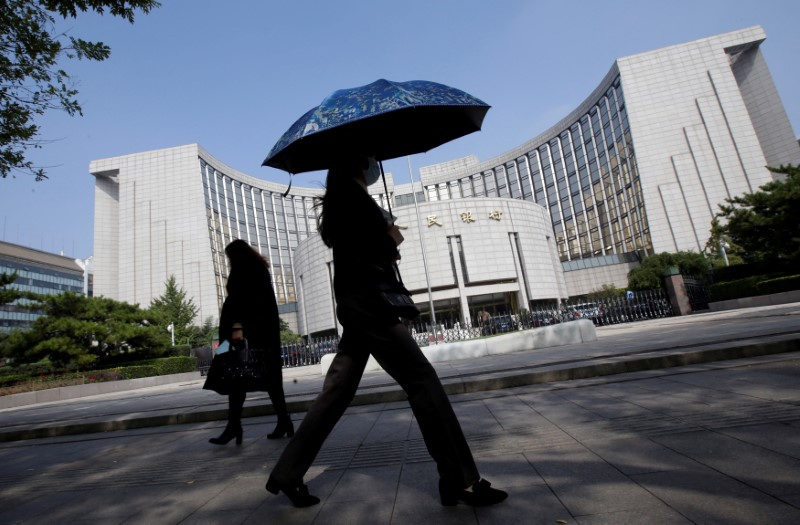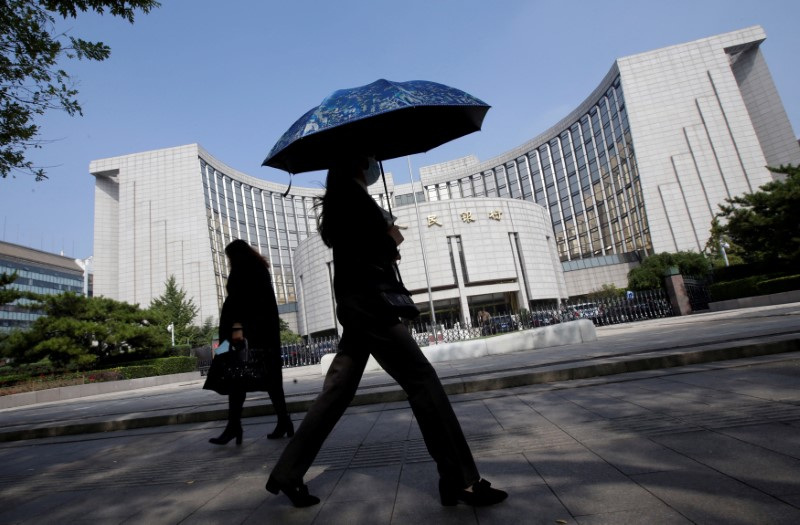
By Kevin Yao
BEIJING (Reuters) – China’s central bank wants to shift its policy framework to target the cost of credit rather than its size, but liquidity risks and uncooperative markets are making it difficult to transition the economy away from state-directed bank lending.
The goal of giving markets a more prominent role in allocating resources was restated at a roughly twice-a-decade Communist Party leadership meeting in July and the People’s Bank of China (PBOC) is expected to play a major role in the reforms.
In recent months, the PBOC has taken steps towards creating a more market-driven interest rate curve, and it is expected to make further changes so that credit demand is more responsive to monetary policy moves.
Longer-term, regulators hope these changes can also lead to the development of capital markets as an alternative source of financing, reducing the risk of wasteful investment by a state-dominated banking system.
But a slowing economy, still heavily reliant on state-led infrastructure investment for growth and in the middle of modernising its industrial complex, has significant liquidity needs. Markets may be unwilling to provide funding in ways the PBOC considers beneficial for national development goals.
In a recent tug-of-war between the PBOC and bond markets, safety flows into bonds pushed down government debt yields to levels that signal bearish bets on China’s growth outlook.
“The PBOC will continue to gradually reform its monetary policy framework towards the type adopted by major central banks globally. However the changes will be slow,” said Louis Kuijs, Asia Pacific chief economist at S&P Global Ratings.
The PBOC has shifted towards targeting the short end of the interest rate curve and announced plans to gradually increase bond trading to influence long-term borrowing costs, but more steps are needed to improve its policy transmission.
“We are moving in the direction of developing market-based interest rates, but it’s an arduous task and the road is long,” said a government adviser who spoke on condition of anonymity as they are not authorised to speak to media.
Future reforms are likely to involve phasing out liquidity supply levers, including credit guidance, analysts and policy advisers say.
For more details, please click on factbox:
LIQUIDITY NEEDS
Credit guidance and other quantitative tools encourage banks to lend irrespective of market demand.
This has created inefficiencies, with idle funds sloshing around the financial system as borrowers often park the money back with the banks in deposits or asset management products.
But phasing these tools out carries risks.
Debt levels of around three times annual economic output, and ambitious annual growth targets – this year’s is set at around 5% – require greater liquidity injections year after year.
Xing Zhaopeng, ANZ’s senior China strategist, estimates the central bank needs to inject approximately 2 trillion yuan ($281 billion) in fresh liquidity annually to support the economy.
The PBOC has indicated that the MLF will be the first to see a reduced monetary policy role.
But at the end of June, outstanding funding through MLF stood at 7.07 trillion yuan ($994.6 billion) – about 5.6% of GDP.
“I don’t expect the MLF to be abruptly cut off as it remains quite important for longer-term financing,” said Lynn Song, chief China economist at ING. “It will be a gradual process.”
MARKET TROUBLE
Market preference for safe assets over other types of investment could lead to an inverted yield curve if the central bank freed up interest rates prematurely, ANZ’s Xing said.
Long-term borrowing costs falling below short-term rates usually signal recessions. In China’s case, that could weaken the yuan and trigger capital flight.
“Once you completely liberalise interest rates, it would be impossible to intervene,” Xing said. “It’s a contradiction: if you let the market work, you have less room to manoeuvre.”
Increasing the role of capital markets in financing growth also requires deep structural changes in the economy alongside interest rate reform.
China’s stock markets are dominated by retail investors and frequently described as a “casino” due to poor liquidity while debt markets are dominated by government-owned issuers, with banks being the main investors.
Low household incomes relative to the size of the economy mean that private pension and insurance markets are small, limiting the number of institutional investors in stocks and bonds and resulting in a shallow capital pool for these assets.
Foreign financial investor flows are also limited as China manages a tight capital account.
There is little public debate on addressing any of these limitations on capital market development.
“What the PBOC is doing regarding long-term interest rates isn’t obviously in line with the long-term reform agenda,” said Kuijs of S&P Global Ratings.
($1 = 7.1086 Chinese yuan)

